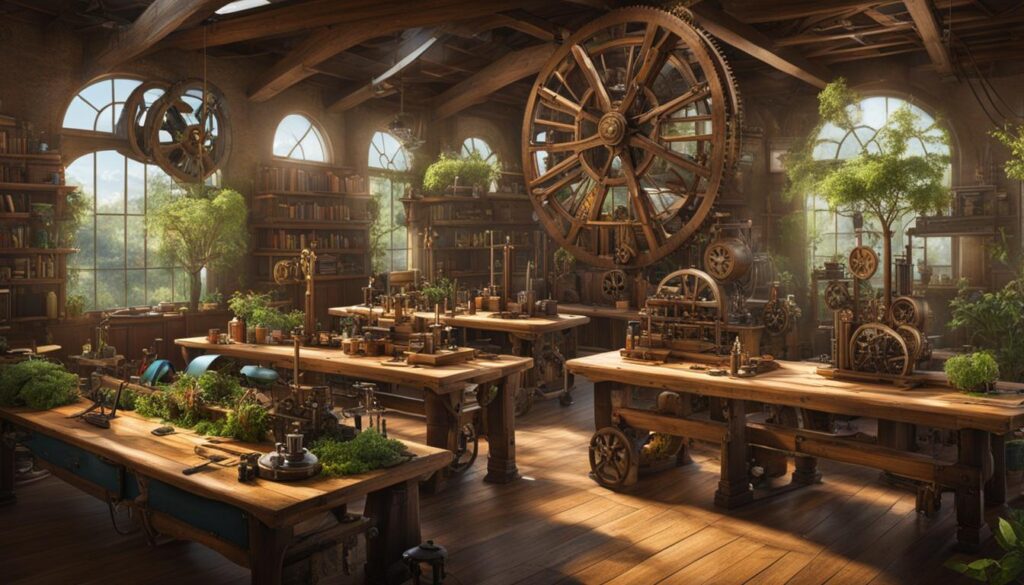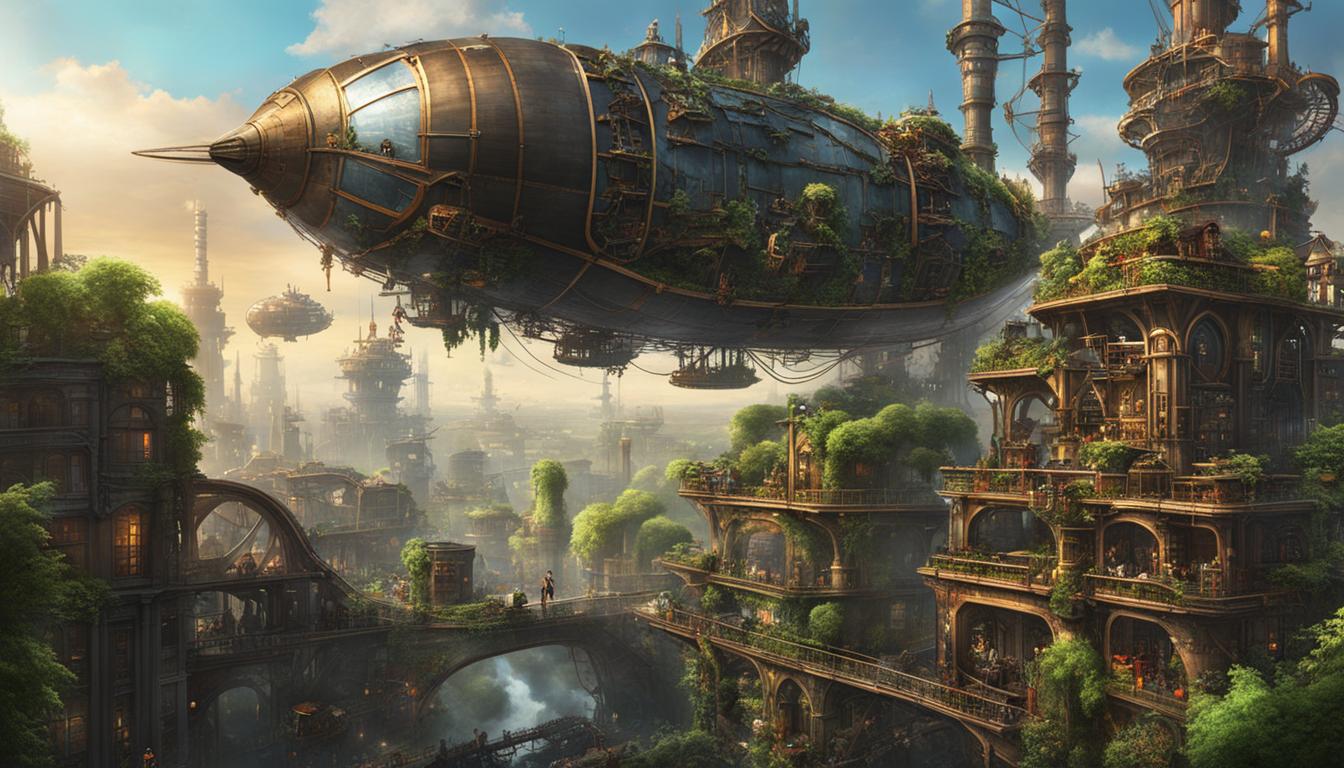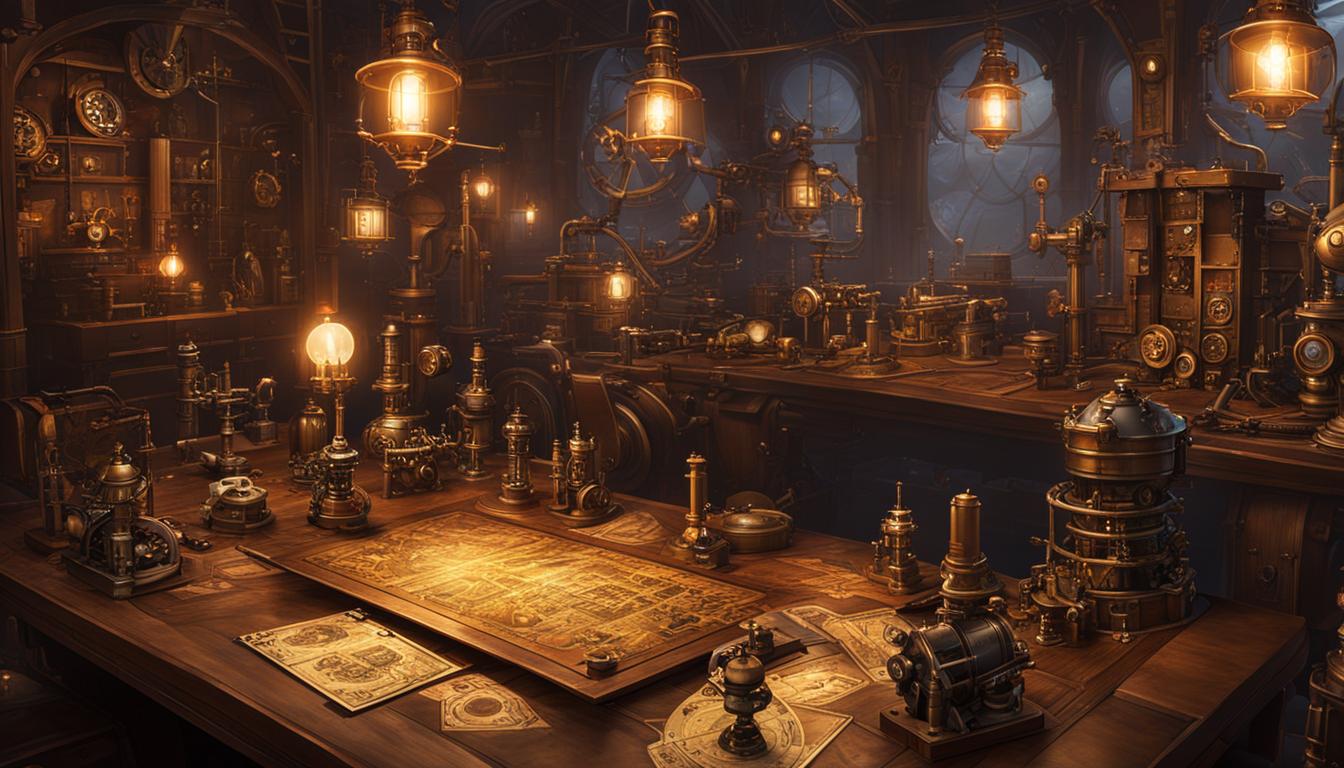Step into a world where Victorian elegance meets futuristic innovation. Steampunk, with its captivating blend of vintage aesthetics and imaginative technology, has captured the hearts of enthusiasts around the globe. But did you know that steampunk is not just a style, but also a powerful advocate for environmental sustainability?
Steampunk’s sustainability themes are deeply rooted in its ethos. The movement encourages repurposing materials, embracing renewable energy sources, and fostering eco-conscious designs. It’s a synergy between the past and the future, where style meets sustainability.
Key Takeaways:
- Steampunk combines Victorian fashion, industrial aesthetics, and futuristic technology.
- Steampunk promotes environmental sustainability through repurposing, renewable energy, and eco-conscious designs.
- Green technology and sustainable practices are integrated into steampunk inventions and gadgets.
- Steampunk serves as a tool for environmental education, raising ecological awareness.
- Embracing the steampunk ethos can pave the way for a sustainable future.
The Eco-Friendly Innovations of Steampunk
Steampunk, known for its imaginative gadgets and fantastical inventions, incorporates more than just whimsical aesthetics. It also embraces green technology and sustainable practices, making it an unexpected ally in the fight for environmental sustainability. Steampunk enthusiasts have demonstrated that vintage aesthetics can coexist with eco-conscious designs, paving the way for a greener future.
One of the most notable eco-friendly innovations in the steampunk realm is the incorporation of green energy sources. Steam-powered vehicles, for example, showcase the potential of renewable energy as an alternative to traditional fossil fuels. By harnessing the power of steam, these vehicles offer a nostalgic yet sustainable mode of transportation.
In addition to steam-powered vehicles, steampunk designs also showcase inventive renewable energy generators. From wind turbines adorned with intricate Victorian detailing to solar-powered gadgets with a touch of industrial charm, these creations prove that sustainable energy solutions can be both functional and visually captivating.
“Steampunk offers a creative and innovative approach to environmental sustainability, incorporating the principles of reduce, reuse, and recycle into its designs,” says Dr. Elizabeth Turner, an environmental scientist and steampunk enthusiast. “The genre challenges us to rethink our relationship with materials and energy, inspiring us to find new ways of repurposing and conserving resources.”
By embracing the principles of sustainability, steampunk enthusiasts are paving the way for a greener future through their imaginative designs. The combination of vintage aesthetics, repurposed materials, and eco-friendly technology exemplifies the possibilities of a harmonious coexistence between style and sustainability.
| Innovations | Description |
|---|---|
| Steam-powered vehicles | Utilize steam as a renewable energy source for transportation. |
| Renewable energy generators | Incorporate intricate Victorian and industrial designs into wind turbines and solar-powered gadgets. |
| Repurposed materials | Showcase the creativity of using salvaged items, reducing waste and promoting resourcefulness. |
| Eco-conscious designs | Highlight the fusion of sustainable practices and vintage aesthetics. |
Steampunk in Environmental Education
Steampunk is a genre that not only captivates with its blend of history and science fiction but also serves as a powerful tool in promoting ecological awareness and environmental education. With its emphasis on repurposing materials and sustainable practices, steampunk enthusiasts are finding innovative ways to engage students and inspire a sense of environmental stewardship.
Through steampunk-themed events, workshops, and educational materials, educators can create immersive experiences that explore green themes and raise ecological awareness. The imaginative and visually stunning world of steampunk serves as a catalyst for discussions on renewable energy, conservation, and sustainable living. By showcasing the potential of alternative energy sources and the importance of reducing waste, steampunk encourages students to become active participants in creating a more environmentally conscious future.
Furthermore, the incorporation of steampunk aesthetics and design principles into the curriculum can provide a unique approach to teaching environmental education. By combining history, science, and art, educators can offer multidisciplinary lessons that spark curiosity and foster a deeper understanding of sustainability. Steampunk’s emphasis on repurposing and upcycling materials can also reinforce the importance of resourcefulness and creative problem-solving.
Steampunk’s role in environmental education goes beyond the classroom. By organizing steampunk-themed community events and exhibitions, educators can engage a wider audience and generate public interest in sustainability. These events offer an opportunity to showcase eco-friendly technologies and designs, inspiring individuals to consider their own environmental impact and take action towards a greener future.

Steampunk’s rich aesthetic and its ability to inspire wonder and curiosity make it a valuable tool for promoting ecological awareness and environmental education. By integrating green themes into the steampunk narrative, educators and enthusiasts can spark conversations about sustainability and inspire future generations to become champions of the environment.
Conclusion
Steampunk, with its unique blend of Victorian fashion, industrial aesthetics, and futuristic technology, is more than just a stylistic choice. It can serve as a powerful platform for promoting environmental sustainability and inspiring a sustainable future.
By embracing the principles of reduce, reuse, and recycle, steampunk enthusiasts are paving the way for a greener world. Their eco-conscious designs showcase the possibilities of combining vintage aesthetics with environmentally friendly innovations. From steam-powered vehicles to renewable energy generators, steampunk proves that style and sustainability can go hand in hand.
Moreover, steampunk’s appeal to a wide range of audiences makes it a valuable tool for raising ecological awareness. Through steampunk-themed events, workshops, and educational materials, educators can engage students in discussions about renewable energy, conservation, and sustainable living. By fostering a sense of wonder and curiosity, steampunk can cultivate a deeper understanding of the importance of environmental stewardship.
As we look towards the future, let us embrace the steampunk ethos and explore the possibilities of a sustainable world. With its emphasis on repurposing materials, utilizing renewable energy sources, and promoting eco-conscious designs, steampunk has the potential to contribute to a more sustainable future for all.
FAQ
What is steampunk?
Steampunk is a unique genre that combines elements of Victorian fashion, industrial aesthetics, and futuristic technology.
How does steampunk promote environmental sustainability?
Steampunk promotes environmental sustainability through its focus on repurposing materials, using renewable energy sources, and creating eco-conscious designs.
What are some examples of eco-friendly innovations in steampunk?
Some examples of eco-friendly innovations in steampunk include steam-powered vehicles and renewable energy generators.
How can steampunk be used in environmental education?
Steampunk can be used in environmental education through events, workshops, and educational materials that engage students in discussions about renewable energy, conservation, and sustainable living.
Why is steampunk a valuable tool for raising ecological awareness?
Steampunk’s blend of history, science fiction, and sustainability appeals to a wide range of audiences, making it an effective tool for raising ecological awareness.
How can steampunk contribute to a sustainable future?
Steampunk can contribute to a sustainable future by promoting eco-conscious designs, green technologies, and environmental education.





